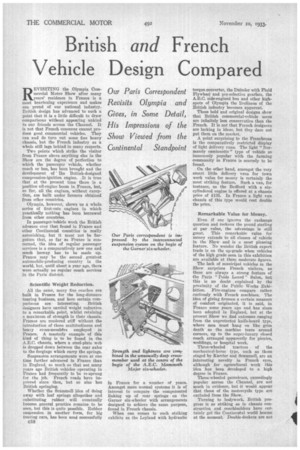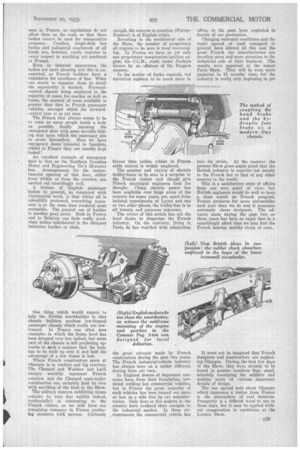British and French
Page 48

Page 49

If you've noticed an error in this article please click here to report it so we can fix it.
Vehicle Design Compared
REVISITING the Olympia Commercial Motor Show after many years' residence in France is a must heartening experience and makes one proud of our national industry. British design bus advanced to such a point that it is a little difficult to draw comparisons without appearing unkind to our friends across the Channel. It is not that French concerns cannot produce good commercial vehicles. They can and do turn out some fine heavy chassis, but the French industry as a whole still lags behind in many respects.
Two points which strike the visitor from France above anything else in the Show are the degree of perfection to which the passenger vehicle, whether coach or bus, bee been brought and the development of ' the British-designed compression-ignition engine. It is true that at the present time there is a positive oil-engine boom in France, but, so far, all the engines, without exception, are built under licences obtained from other countries.
Olympia, however, shows us a whole series of first-rate engines in which practically nothing has been borrowed from other countries.
In passenger-vehicle work the British advance over that found in France and other Continental countries is really astonishing, but it must not be forgotten that, so far as France is concerned, the idea of regular passenger services is a comparatively new one and mach leeway has to be made up. France may be the second greatest automobile-producing country in the world, but, until about a year ago, there were actually no regular coach services in the Paris district.
Scientific Weight Reduction.
All the same, many fine coaches are built in France for the long-distance touring business, and here certain comparisons are interesting. British designers have carried weight reduction to a remarkable point, whilst retaining a maximum of strength in their chassis. Frames are rendered stiff without the introduction of those multitudinous and heavy cross-members employed in France. A masterly example of this kind of thing is to be found in the A.E.G. chassis, where a steel-plate web is dropped down between the rear axles to the forgings which carry the springs.
Suspension arrangements were at one time further advanced in France than in England, so much so that not many years ago British vehicles operating in France had frequently to be re-sprung for the job. French roads have improved since then, but so also has British springing.
Whether the Seamtnell idea of doing away with leaf springs altogether and substituting rubber will eventually become general practice remains to be seen, but this is quite possible. Rubber suspension in another form, for big touring cars, has been used successfully in France for a number of years. Amongst more normal systems it is of interest to compare the compensated linking up of rear springs on the Garner six-wheeler with arrangements designed to achieve the same purpose, found in French chassis.
When one comes to such striking exhibits as the Leyland with hydraulic torque converter, the Daimler with Fluid Flywheel and pre-selective gearbox, the A.E.C. side-engined bus and other highspots of Olympia the liveliness of the British industry becomes apparent.
These bold and original designs show that British commercial-vehicle users are infinitely less conservative than the French. It is not that French designers are lacking in ideas, but they dare not put them on the market.
A point surprising to the Frenchman is the comparatively restricted display of light delivery viins. The light "Normandy can3ionette " type of vehicle so immensely popular with the farming community in France is scarcely to be found.
On the other heed, amongst the very smart little delivery vans for town work value for money is certainly the most striking feature. Such a van, for instance, as the Bedford -with a sixcylindered engine is offered at a chassis price of £135. In France a light van chassis of this type would cost double the price.
Remarkable Value for Money.
Even if one ignores the exchange question and reckons the pound sterling at par value, the advantage is still great. This remarkable value for money extends to all classes of vehicle in the Show and is a most pleasing feature. No wonder the British export trade is on the up-grade when vehicles of the high grade seen, in this exhibition are available at these moderate figures.
The lack of municipal vehicles in the Show surprises French visitors, as these are always a strong feature of the Paris" Poids Lourd " Salon, but this is no doubt explained by the proximity of the Public Works Exhibition. Fire-engines compare rather curiously with French machines. The idea of giving firemen a certain measure of comfort originated, it is said, in France some yours ago and has since been adopted in England, but at the preSent Show we find extremes ranging from the unprotected knife-board type, where men must hang on like grim deathas the machine tears around corners, up to the super-luxury closed coach arranged apparently for picnics, weddings, or hospital work.
Three-wheeled tractors of the mechanical-horse type, such as those staged by Earlier and Seammell, are an interesting novelty in French eyes, although for agricultural work this idea has been developed to a high degree in France.
Three-wheeled parcelcars, exceedingly popular across the Channel, are not much in evidence, but it would appear that those of the motorcycle type are excluded from the Show.
Turning to bodywork, British progress is as striking as in chassis construction and coachbuilders have certainly got the Continentel world beaten at the moment. Double-deckers are not seen in France, as regulations do not allow them on the road, so that these bodies cannot be used for comparative purposes. Coaches, single-deck bus bodies and industrial coachwork of all kinds are, however, vastly superior in every respect to anything yet produced in France.
Even in internal appearance the bodies are more pleasing and this is unexpected, as French builders have a reputation for excellence of line. When one starts to examine them in detail the superiority is marked. Forwardcontrol chassis being employed in the majority of cases, for coaches as well as buses, the amount of room available is greater than that in French passenger vehicles, amongst which the forwardcontrol type is as yet rare.
The French idea always seems to be to cram as many people inside a body as possible, finally jamming the emergency door with some horrible folding seat upon which the passenger sits in acute discomfort. Here we have emergency doors intended to function, whilst in France they are usually kept locked!
An excellent example of emergency door is that on the Northern Counties Motor and Engineering Co.'s 32-seater bus. Arrangements for the instantaneous opening of this door, either from within or from the exterior, are carried out exceedingly well.
A feature of English passenger bodies in general, as compared with Continental work, is that whilst all is splendidly protected, everything itemsmiry is at the same time rendered most eccessible. The general use of leather is another good point. Both in France and in Belgium one finds really goodclass bodies upholstered in the cheapest imitation leather or cloth.
One thing which would appear to help the British coachbuilder is that chassis builders produce low-framed passenger chassis which really are lowframed. In France one often sees examples in which the frame level has been dropped very low indeed, but some part of the chassis is left projecting upwards in seta a manner that the body has to be built up over it and half the advantage of a low frame is lost.
Where French constructors score at Olympia is in trailers and big tractors. The Chenard and Waleker and Leta designs worthily represent French Practice, and the Chenard semi-trailer combination can certainly hold its own with anything of the kind in the Show. The solitary concern exhibiting steam vehicles (a very fine exhibit indeed, incidentally) is interesting to the French visitor, as we still have one remaining company in France producing steamers with success. Curiously enough, the concern in question (PurreyExshaw) is of English origin.
Reverting to the mechanical side of the Show, the number of proprietary oil engines to be seen is most encouraging. In France we have as yet only one proprietary compression-ignition engine, the C.L.M., made under Sunkers licence by an offshoot of the Peugeot concern.
In the matter of brake controls, rod operation aptrears to be much more in favour than cables, whilst in France cable control is widely employed.
The number and variety of electric trolley-buses to be seen is a surprise to the French visitor and should give French municipal engineers food for thought. Cheap electric power has been available over large areas of the country for many years, yet, apart from isolated experiments at Lyons and one or two other places, the trolley-bus is to all intents and purposes unknown.
The writer of this article has not the least desire to disparage the French industry. On the contrary, living in Paris, he has watched with admiration the great advance made by French constructors during the past two years. The French industrial-vehicle industry has always been on a rather different footing from our own.
In England dozens of important concerns have, from their foundation, produced nothing but commercial vehicles, but in France the great majority of such vehicles has been turned out more or less as a side line by car manufacturers. Only four or five makers in the country have confined their energies to the industrial market. In these circumstances the commercial vehicle has often, in the past, been neglected in favour of car production.
Changing economic conditions and the rapid spread of road transport in general have altered all this and the great French car manufacturers are devoting more and more attention to the industrial side of their business. The results were apparent at the recent Paris Show. They will be even more apparent in 12 months' time, for the industry is really_ only beginning to get into its stride. At the moment the present Show gives ample proof that the British industry is superior not merely to the French but to that of any other country in the world.
This is a satisfactory state of affairs from our own point of view, but British engineers would do well to keep a close watch on French progress. France produces far more automobiles each year than we do and it possesses extremely clever designers. The adranee made during the past two or three years has been so rapid that in a surprisingly short time we may find the French heavies worthy rivals of ours.
It must not be imagined that French designers and constructors are neglecting Olympia. During the first few days of the Show, they were already to be found in greater numbers than usual, minutely examining the exhibits and making notes of various important details of design.
The one special note about Olympia which impresses a visitor from France is the atmosphere of real business. Prosperity is a difficult word to use in these dab's, but it may be applied without exaggeration to conditions at the London Show.




























































































































